Analyzing Supply Chain Strategy & Operations: The Case of Disney Paris
VerifiedAdded on 2023/05/29
|7
|2890
|499
Case Study
AI Summary
This case study provides an evaluation of Disneyland Paris, focusing on its supply chain strategy and operations. It begins by detailing the history and development of the park, including its expansion plans and initial challenges related to workforce issues and low attendance. The study then presents recommendations for improvement, emphasizing the importance of capitalizing on strengths such as building cooperative growth and developing a strong brand. It also addresses weaknesses like limited diversification and innovation, and opportunities such as leveraging technology and expanding into developing markets. Finally, the case study discusses the risks faced by Disney, including competition, technological disruptions, and security concerns, highlighting the need for proactive risk management and strategic partnerships to ensure continued success. Desklib provides access to this and similar case studies to aid students in their academic endeavors.
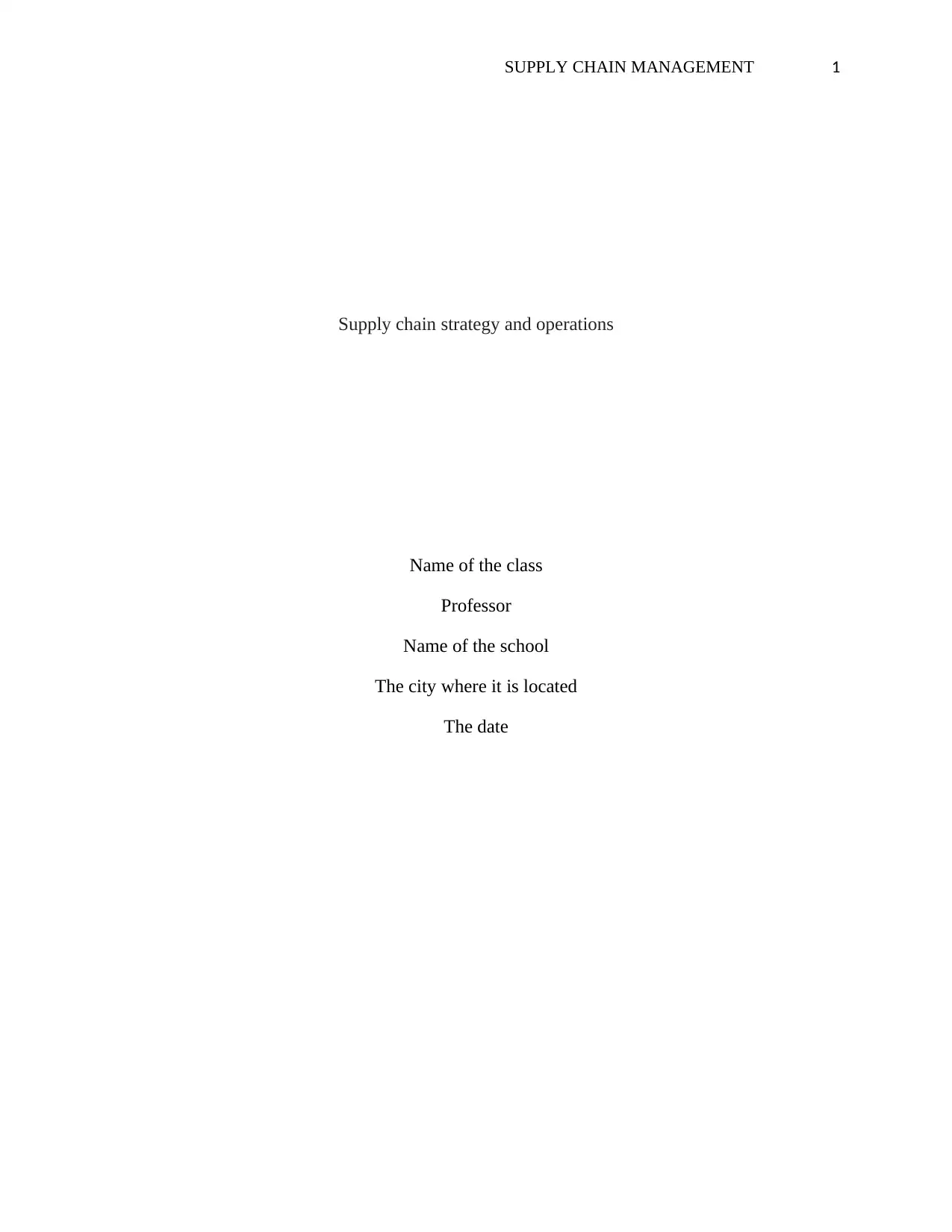
SUPPLY CHAIN MANAGEMENT 1
Supply chain strategy and operations
Name of the class
Professor
Name of the school
The city where it is located
The date
Supply chain strategy and operations
Name of the class
Professor
Name of the school
The city where it is located
The date
Paraphrase This Document
Need a fresh take? Get an instant paraphrase of this document with our AI Paraphraser
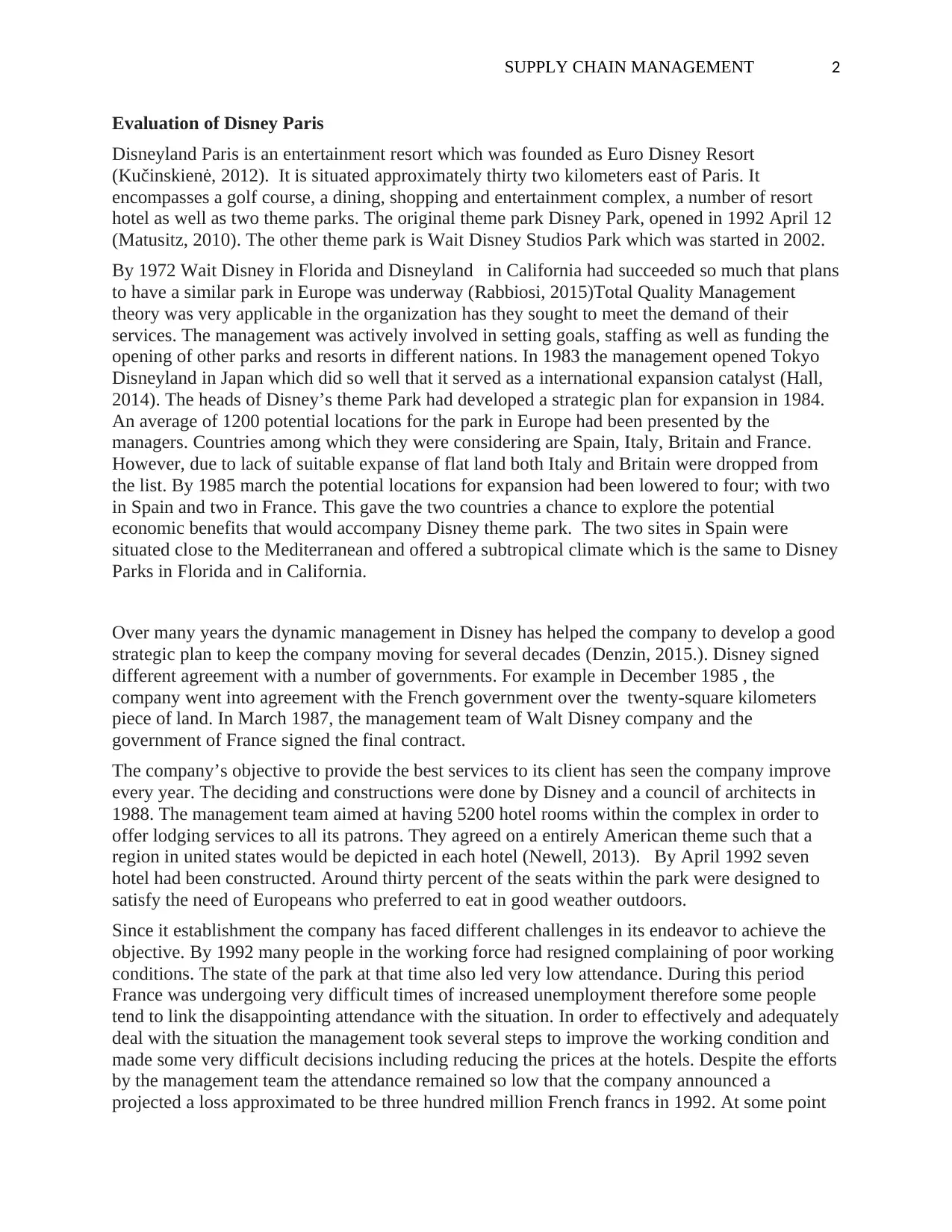
SUPPLY CHAIN MANAGEMENT 2
Evaluation of Disney Paris
Disneyland Paris is an entertainment resort which was founded as Euro Disney Resort
(Kučinskienė, 2012). It is situated approximately thirty two kilometers east of Paris. It
encompasses a golf course, a dining, shopping and entertainment complex, a number of resort
hotel as well as two theme parks. The original theme park Disney Park, opened in 1992 April 12
(Matusitz, 2010). The other theme park is Wait Disney Studios Park which was started in 2002.
By 1972 Wait Disney in Florida and Disneyland in California had succeeded so much that plans
to have a similar park in Europe was underway (Rabbiosi, 2015)Total Quality Management
theory was very applicable in the organization has they sought to meet the demand of their
services. The management was actively involved in setting goals, staffing as well as funding the
opening of other parks and resorts in different nations. In 1983 the management opened Tokyo
Disneyland in Japan which did so well that it served as a international expansion catalyst (Hall,
2014). The heads of Disney’s theme Park had developed a strategic plan for expansion in 1984.
An average of 1200 potential locations for the park in Europe had been presented by the
managers. Countries among which they were considering are Spain, Italy, Britain and France.
However, due to lack of suitable expanse of flat land both Italy and Britain were dropped from
the list. By 1985 march the potential locations for expansion had been lowered to four; with two
in Spain and two in France. This gave the two countries a chance to explore the potential
economic benefits that would accompany Disney theme park. The two sites in Spain were
situated close to the Mediterranean and offered a subtropical climate which is the same to Disney
Parks in Florida and in California.
Over many years the dynamic management in Disney has helped the company to develop a good
strategic plan to keep the company moving for several decades (Denzin, 2015.). Disney signed
different agreement with a number of governments. For example in December 1985 , the
company went into agreement with the French government over the twenty-square kilometers
piece of land. In March 1987, the management team of Walt Disney company and the
government of France signed the final contract.
The company’s objective to provide the best services to its client has seen the company improve
every year. The deciding and constructions were done by Disney and a council of architects in
1988. The management team aimed at having 5200 hotel rooms within the complex in order to
offer lodging services to all its patrons. They agreed on a entirely American theme such that a
region in united states would be depicted in each hotel (Newell, 2013). By April 1992 seven
hotel had been constructed. Around thirty percent of the seats within the park were designed to
satisfy the need of Europeans who preferred to eat in good weather outdoors.
Since it establishment the company has faced different challenges in its endeavor to achieve the
objective. By 1992 many people in the working force had resigned complaining of poor working
conditions. The state of the park at that time also led very low attendance. During this period
France was undergoing very difficult times of increased unemployment therefore some people
tend to link the disappointing attendance with the situation. In order to effectively and adequately
deal with the situation the management took several steps to improve the working condition and
made some very difficult decisions including reducing the prices at the hotels. Despite the efforts
by the management team the attendance remained so low that the company announced a
projected a loss approximated to be three hundred million French francs in 1992. At some point
Evaluation of Disney Paris
Disneyland Paris is an entertainment resort which was founded as Euro Disney Resort
(Kučinskienė, 2012). It is situated approximately thirty two kilometers east of Paris. It
encompasses a golf course, a dining, shopping and entertainment complex, a number of resort
hotel as well as two theme parks. The original theme park Disney Park, opened in 1992 April 12
(Matusitz, 2010). The other theme park is Wait Disney Studios Park which was started in 2002.
By 1972 Wait Disney in Florida and Disneyland in California had succeeded so much that plans
to have a similar park in Europe was underway (Rabbiosi, 2015)Total Quality Management
theory was very applicable in the organization has they sought to meet the demand of their
services. The management was actively involved in setting goals, staffing as well as funding the
opening of other parks and resorts in different nations. In 1983 the management opened Tokyo
Disneyland in Japan which did so well that it served as a international expansion catalyst (Hall,
2014). The heads of Disney’s theme Park had developed a strategic plan for expansion in 1984.
An average of 1200 potential locations for the park in Europe had been presented by the
managers. Countries among which they were considering are Spain, Italy, Britain and France.
However, due to lack of suitable expanse of flat land both Italy and Britain were dropped from
the list. By 1985 march the potential locations for expansion had been lowered to four; with two
in Spain and two in France. This gave the two countries a chance to explore the potential
economic benefits that would accompany Disney theme park. The two sites in Spain were
situated close to the Mediterranean and offered a subtropical climate which is the same to Disney
Parks in Florida and in California.
Over many years the dynamic management in Disney has helped the company to develop a good
strategic plan to keep the company moving for several decades (Denzin, 2015.). Disney signed
different agreement with a number of governments. For example in December 1985 , the
company went into agreement with the French government over the twenty-square kilometers
piece of land. In March 1987, the management team of Walt Disney company and the
government of France signed the final contract.
The company’s objective to provide the best services to its client has seen the company improve
every year. The deciding and constructions were done by Disney and a council of architects in
1988. The management team aimed at having 5200 hotel rooms within the complex in order to
offer lodging services to all its patrons. They agreed on a entirely American theme such that a
region in united states would be depicted in each hotel (Newell, 2013). By April 1992 seven
hotel had been constructed. Around thirty percent of the seats within the park were designed to
satisfy the need of Europeans who preferred to eat in good weather outdoors.
Since it establishment the company has faced different challenges in its endeavor to achieve the
objective. By 1992 many people in the working force had resigned complaining of poor working
conditions. The state of the park at that time also led very low attendance. During this period
France was undergoing very difficult times of increased unemployment therefore some people
tend to link the disappointing attendance with the situation. In order to effectively and adequately
deal with the situation the management took several steps to improve the working condition and
made some very difficult decisions including reducing the prices at the hotels. Despite the efforts
by the management team the attendance remained so low that the company announced a
projected a loss approximated to be three hundred million French francs in 1992. At some point
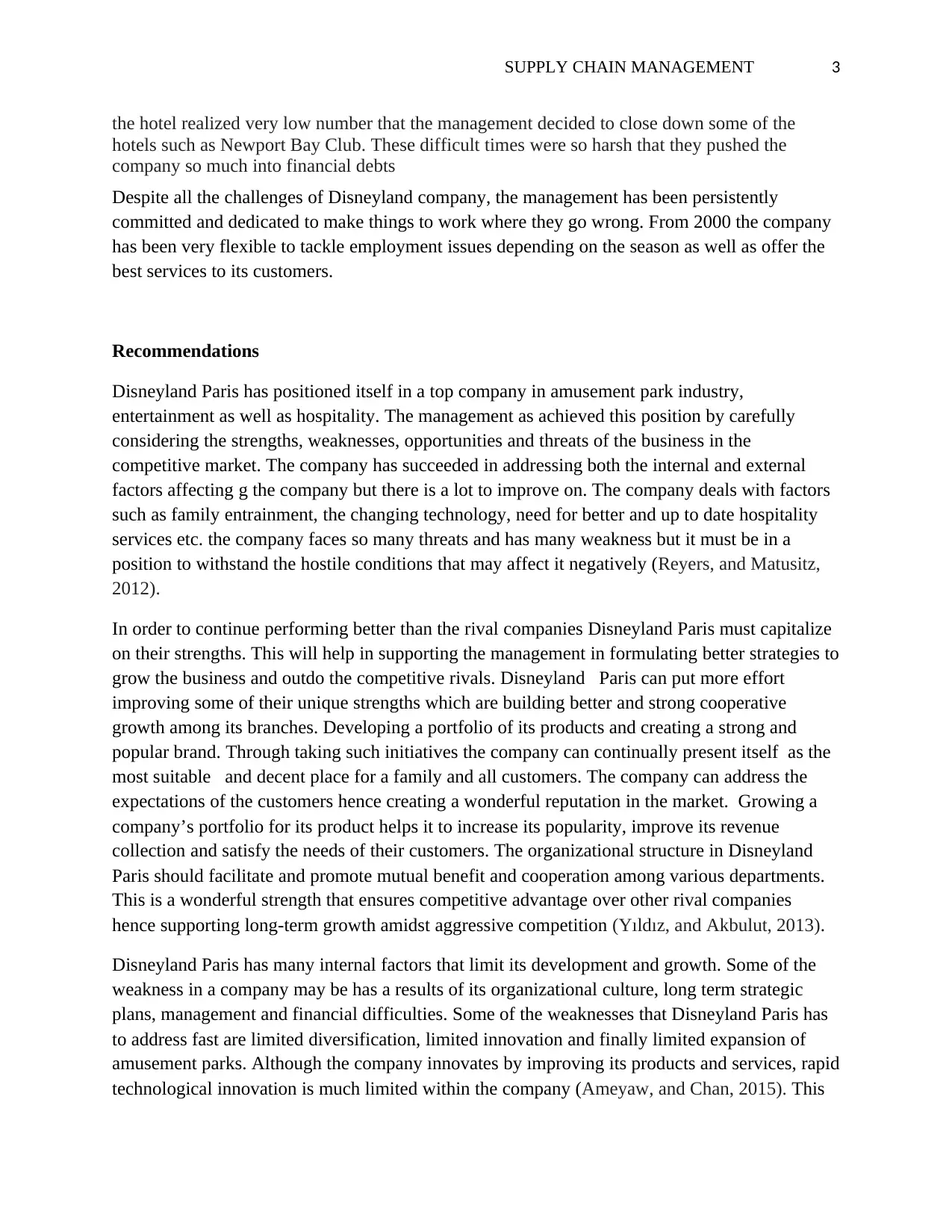
SUPPLY CHAIN MANAGEMENT 3
the hotel realized very low number that the management decided to close down some of the
hotels such as Newport Bay Club. These difficult times were so harsh that they pushed the
company so much into financial debts
Despite all the challenges of Disneyland company, the management has been persistently
committed and dedicated to make things to work where they go wrong. From 2000 the company
has been very flexible to tackle employment issues depending on the season as well as offer the
best services to its customers.
Recommendations
Disneyland Paris has positioned itself in a top company in amusement park industry,
entertainment as well as hospitality. The management as achieved this position by carefully
considering the strengths, weaknesses, opportunities and threats of the business in the
competitive market. The company has succeeded in addressing both the internal and external
factors affecting g the company but there is a lot to improve on. The company deals with factors
such as family entrainment, the changing technology, need for better and up to date hospitality
services etc. the company faces so many threats and has many weakness but it must be in a
position to withstand the hostile conditions that may affect it negatively (Reyers, and Matusitz,
2012).
In order to continue performing better than the rival companies Disneyland Paris must capitalize
on their strengths. This will help in supporting the management in formulating better strategies to
grow the business and outdo the competitive rivals. Disneyland Paris can put more effort
improving some of their unique strengths which are building better and strong cooperative
growth among its branches. Developing a portfolio of its products and creating a strong and
popular brand. Through taking such initiatives the company can continually present itself as the
most suitable and decent place for a family and all customers. The company can address the
expectations of the customers hence creating a wonderful reputation in the market. Growing a
company’s portfolio for its product helps it to increase its popularity, improve its revenue
collection and satisfy the needs of their customers. The organizational structure in Disneyland
Paris should facilitate and promote mutual benefit and cooperation among various departments.
This is a wonderful strength that ensures competitive advantage over other rival companies
hence supporting long-term growth amidst aggressive competition (Yıldız, and Akbulut, 2013).
Disneyland Paris has many internal factors that limit its development and growth. Some of the
weakness in a company may be has a results of its organizational culture, long term strategic
plans, management and financial difficulties. Some of the weaknesses that Disneyland Paris has
to address fast are limited diversification, limited innovation and finally limited expansion of
amusement parks. Although the company innovates by improving its products and services, rapid
technological innovation is much limited within the company (Ameyaw, and Chan, 2015). This
the hotel realized very low number that the management decided to close down some of the
hotels such as Newport Bay Club. These difficult times were so harsh that they pushed the
company so much into financial debts
Despite all the challenges of Disneyland company, the management has been persistently
committed and dedicated to make things to work where they go wrong. From 2000 the company
has been very flexible to tackle employment issues depending on the season as well as offer the
best services to its customers.
Recommendations
Disneyland Paris has positioned itself in a top company in amusement park industry,
entertainment as well as hospitality. The management as achieved this position by carefully
considering the strengths, weaknesses, opportunities and threats of the business in the
competitive market. The company has succeeded in addressing both the internal and external
factors affecting g the company but there is a lot to improve on. The company deals with factors
such as family entrainment, the changing technology, need for better and up to date hospitality
services etc. the company faces so many threats and has many weakness but it must be in a
position to withstand the hostile conditions that may affect it negatively (Reyers, and Matusitz,
2012).
In order to continue performing better than the rival companies Disneyland Paris must capitalize
on their strengths. This will help in supporting the management in formulating better strategies to
grow the business and outdo the competitive rivals. Disneyland Paris can put more effort
improving some of their unique strengths which are building better and strong cooperative
growth among its branches. Developing a portfolio of its products and creating a strong and
popular brand. Through taking such initiatives the company can continually present itself as the
most suitable and decent place for a family and all customers. The company can address the
expectations of the customers hence creating a wonderful reputation in the market. Growing a
company’s portfolio for its product helps it to increase its popularity, improve its revenue
collection and satisfy the needs of their customers. The organizational structure in Disneyland
Paris should facilitate and promote mutual benefit and cooperation among various departments.
This is a wonderful strength that ensures competitive advantage over other rival companies
hence supporting long-term growth amidst aggressive competition (Yıldız, and Akbulut, 2013).
Disneyland Paris has many internal factors that limit its development and growth. Some of the
weakness in a company may be has a results of its organizational culture, long term strategic
plans, management and financial difficulties. Some of the weaknesses that Disneyland Paris has
to address fast are limited diversification, limited innovation and finally limited expansion of
amusement parks. Although the company innovates by improving its products and services, rapid
technological innovation is much limited within the company (Ameyaw, and Chan, 2015). This
⊘ This is a preview!⊘
Do you want full access?
Subscribe today to unlock all pages.

Trusted by 1+ million students worldwide
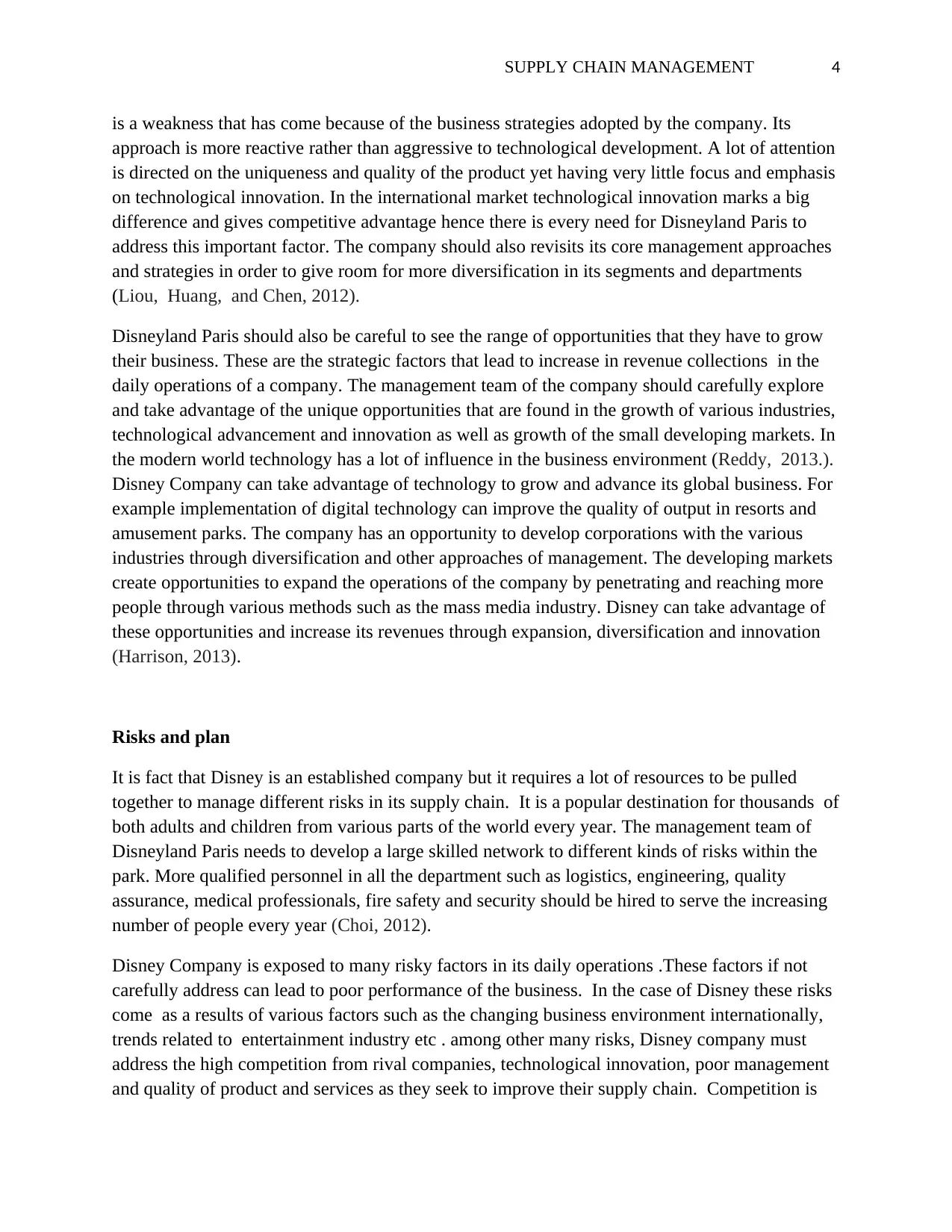
SUPPLY CHAIN MANAGEMENT 4
is a weakness that has come because of the business strategies adopted by the company. Its
approach is more reactive rather than aggressive to technological development. A lot of attention
is directed on the uniqueness and quality of the product yet having very little focus and emphasis
on technological innovation. In the international market technological innovation marks a big
difference and gives competitive advantage hence there is every need for Disneyland Paris to
address this important factor. The company should also revisits its core management approaches
and strategies in order to give room for more diversification in its segments and departments
(Liou, Huang, and Chen, 2012).
Disneyland Paris should also be careful to see the range of opportunities that they have to grow
their business. These are the strategic factors that lead to increase in revenue collections in the
daily operations of a company. The management team of the company should carefully explore
and take advantage of the unique opportunities that are found in the growth of various industries,
technological advancement and innovation as well as growth of the small developing markets. In
the modern world technology has a lot of influence in the business environment (Reddy, 2013.).
Disney Company can take advantage of technology to grow and advance its global business. For
example implementation of digital technology can improve the quality of output in resorts and
amusement parks. The company has an opportunity to develop corporations with the various
industries through diversification and other approaches of management. The developing markets
create opportunities to expand the operations of the company by penetrating and reaching more
people through various methods such as the mass media industry. Disney can take advantage of
these opportunities and increase its revenues through expansion, diversification and innovation
(Harrison, 2013).
Risks and plan
It is fact that Disney is an established company but it requires a lot of resources to be pulled
together to manage different risks in its supply chain. It is a popular destination for thousands of
both adults and children from various parts of the world every year. The management team of
Disneyland Paris needs to develop a large skilled network to different kinds of risks within the
park. More qualified personnel in all the department such as logistics, engineering, quality
assurance, medical professionals, fire safety and security should be hired to serve the increasing
number of people every year (Choi, 2012).
Disney Company is exposed to many risky factors in its daily operations .These factors if not
carefully address can lead to poor performance of the business. In the case of Disney these risks
come as a results of various factors such as the changing business environment internationally,
trends related to entertainment industry etc . among other many risks, Disney company must
address the high competition from rival companies, technological innovation, poor management
and quality of product and services as they seek to improve their supply chain. Competition is
is a weakness that has come because of the business strategies adopted by the company. Its
approach is more reactive rather than aggressive to technological development. A lot of attention
is directed on the uniqueness and quality of the product yet having very little focus and emphasis
on technological innovation. In the international market technological innovation marks a big
difference and gives competitive advantage hence there is every need for Disneyland Paris to
address this important factor. The company should also revisits its core management approaches
and strategies in order to give room for more diversification in its segments and departments
(Liou, Huang, and Chen, 2012).
Disneyland Paris should also be careful to see the range of opportunities that they have to grow
their business. These are the strategic factors that lead to increase in revenue collections in the
daily operations of a company. The management team of the company should carefully explore
and take advantage of the unique opportunities that are found in the growth of various industries,
technological advancement and innovation as well as growth of the small developing markets. In
the modern world technology has a lot of influence in the business environment (Reddy, 2013.).
Disney Company can take advantage of technology to grow and advance its global business. For
example implementation of digital technology can improve the quality of output in resorts and
amusement parks. The company has an opportunity to develop corporations with the various
industries through diversification and other approaches of management. The developing markets
create opportunities to expand the operations of the company by penetrating and reaching more
people through various methods such as the mass media industry. Disney can take advantage of
these opportunities and increase its revenues through expansion, diversification and innovation
(Harrison, 2013).
Risks and plan
It is fact that Disney is an established company but it requires a lot of resources to be pulled
together to manage different risks in its supply chain. It is a popular destination for thousands of
both adults and children from various parts of the world every year. The management team of
Disneyland Paris needs to develop a large skilled network to different kinds of risks within the
park. More qualified personnel in all the department such as logistics, engineering, quality
assurance, medical professionals, fire safety and security should be hired to serve the increasing
number of people every year (Choi, 2012).
Disney Company is exposed to many risky factors in its daily operations .These factors if not
carefully address can lead to poor performance of the business. In the case of Disney these risks
come as a results of various factors such as the changing business environment internationally,
trends related to entertainment industry etc . among other many risks, Disney company must
address the high competition from rival companies, technological innovation, poor management
and quality of product and services as they seek to improve their supply chain. Competition is
Paraphrase This Document
Need a fresh take? Get an instant paraphrase of this document with our AI Paraphraser
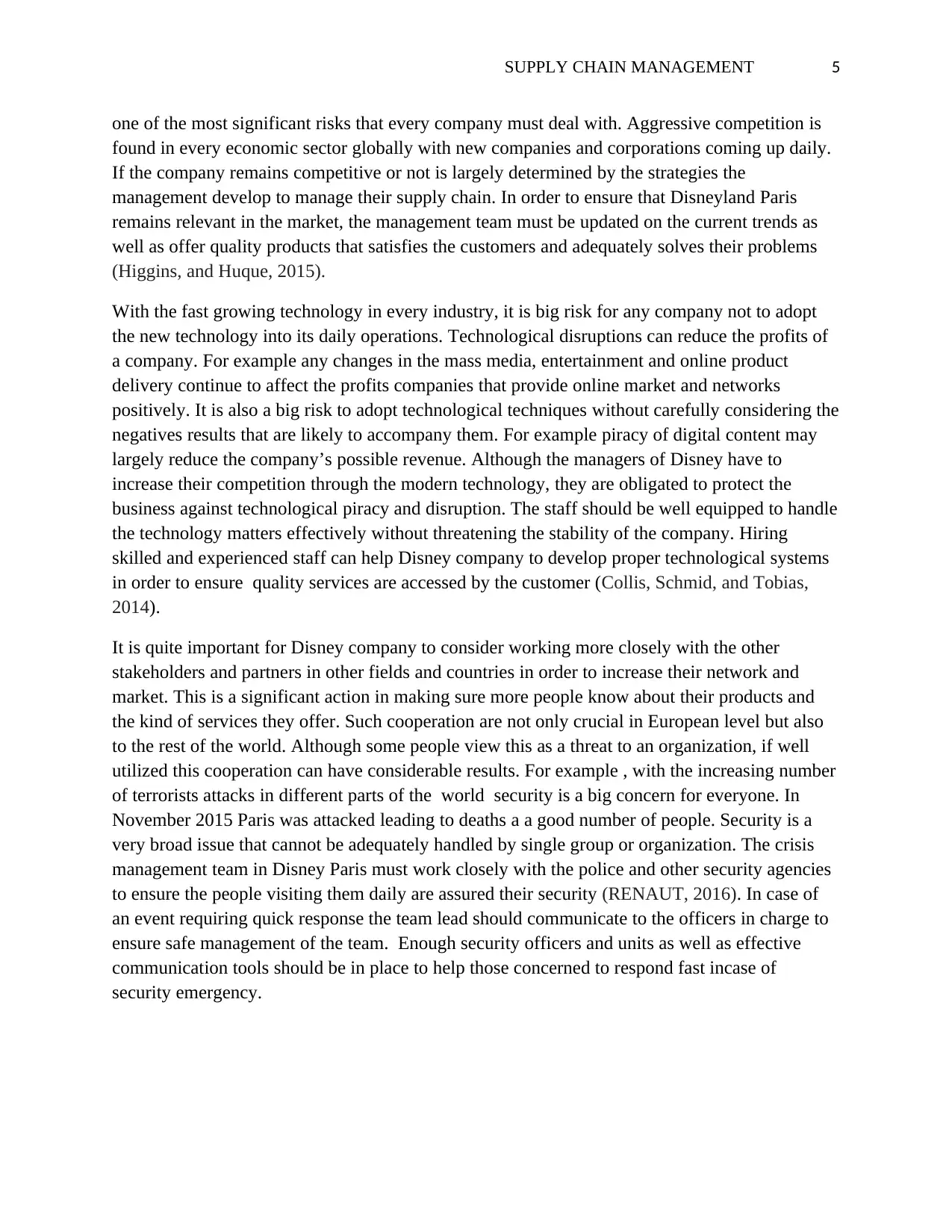
SUPPLY CHAIN MANAGEMENT 5
one of the most significant risks that every company must deal with. Aggressive competition is
found in every economic sector globally with new companies and corporations coming up daily.
If the company remains competitive or not is largely determined by the strategies the
management develop to manage their supply chain. In order to ensure that Disneyland Paris
remains relevant in the market, the management team must be updated on the current trends as
well as offer quality products that satisfies the customers and adequately solves their problems
(Higgins, and Huque, 2015).
With the fast growing technology in every industry, it is big risk for any company not to adopt
the new technology into its daily operations. Technological disruptions can reduce the profits of
a company. For example any changes in the mass media, entertainment and online product
delivery continue to affect the profits companies that provide online market and networks
positively. It is also a big risk to adopt technological techniques without carefully considering the
negatives results that are likely to accompany them. For example piracy of digital content may
largely reduce the company’s possible revenue. Although the managers of Disney have to
increase their competition through the modern technology, they are obligated to protect the
business against technological piracy and disruption. The staff should be well equipped to handle
the technology matters effectively without threatening the stability of the company. Hiring
skilled and experienced staff can help Disney company to develop proper technological systems
in order to ensure quality services are accessed by the customer (Collis, Schmid, and Tobias,
2014).
It is quite important for Disney company to consider working more closely with the other
stakeholders and partners in other fields and countries in order to increase their network and
market. This is a significant action in making sure more people know about their products and
the kind of services they offer. Such cooperation are not only crucial in European level but also
to the rest of the world. Although some people view this as a threat to an organization, if well
utilized this cooperation can have considerable results. For example , with the increasing number
of terrorists attacks in different parts of the world security is a big concern for everyone. In
November 2015 Paris was attacked leading to deaths a a good number of people. Security is a
very broad issue that cannot be adequately handled by single group or organization. The crisis
management team in Disney Paris must work closely with the police and other security agencies
to ensure the people visiting them daily are assured their security (RENAUT, 2016). In case of
an event requiring quick response the team lead should communicate to the officers in charge to
ensure safe management of the team. Enough security officers and units as well as effective
communication tools should be in place to help those concerned to respond fast incase of
security emergency.
one of the most significant risks that every company must deal with. Aggressive competition is
found in every economic sector globally with new companies and corporations coming up daily.
If the company remains competitive or not is largely determined by the strategies the
management develop to manage their supply chain. In order to ensure that Disneyland Paris
remains relevant in the market, the management team must be updated on the current trends as
well as offer quality products that satisfies the customers and adequately solves their problems
(Higgins, and Huque, 2015).
With the fast growing technology in every industry, it is big risk for any company not to adopt
the new technology into its daily operations. Technological disruptions can reduce the profits of
a company. For example any changes in the mass media, entertainment and online product
delivery continue to affect the profits companies that provide online market and networks
positively. It is also a big risk to adopt technological techniques without carefully considering the
negatives results that are likely to accompany them. For example piracy of digital content may
largely reduce the company’s possible revenue. Although the managers of Disney have to
increase their competition through the modern technology, they are obligated to protect the
business against technological piracy and disruption. The staff should be well equipped to handle
the technology matters effectively without threatening the stability of the company. Hiring
skilled and experienced staff can help Disney company to develop proper technological systems
in order to ensure quality services are accessed by the customer (Collis, Schmid, and Tobias,
2014).
It is quite important for Disney company to consider working more closely with the other
stakeholders and partners in other fields and countries in order to increase their network and
market. This is a significant action in making sure more people know about their products and
the kind of services they offer. Such cooperation are not only crucial in European level but also
to the rest of the world. Although some people view this as a threat to an organization, if well
utilized this cooperation can have considerable results. For example , with the increasing number
of terrorists attacks in different parts of the world security is a big concern for everyone. In
November 2015 Paris was attacked leading to deaths a a good number of people. Security is a
very broad issue that cannot be adequately handled by single group or organization. The crisis
management team in Disney Paris must work closely with the police and other security agencies
to ensure the people visiting them daily are assured their security (RENAUT, 2016). In case of
an event requiring quick response the team lead should communicate to the officers in charge to
ensure safe management of the team. Enough security officers and units as well as effective
communication tools should be in place to help those concerned to respond fast incase of
security emergency.
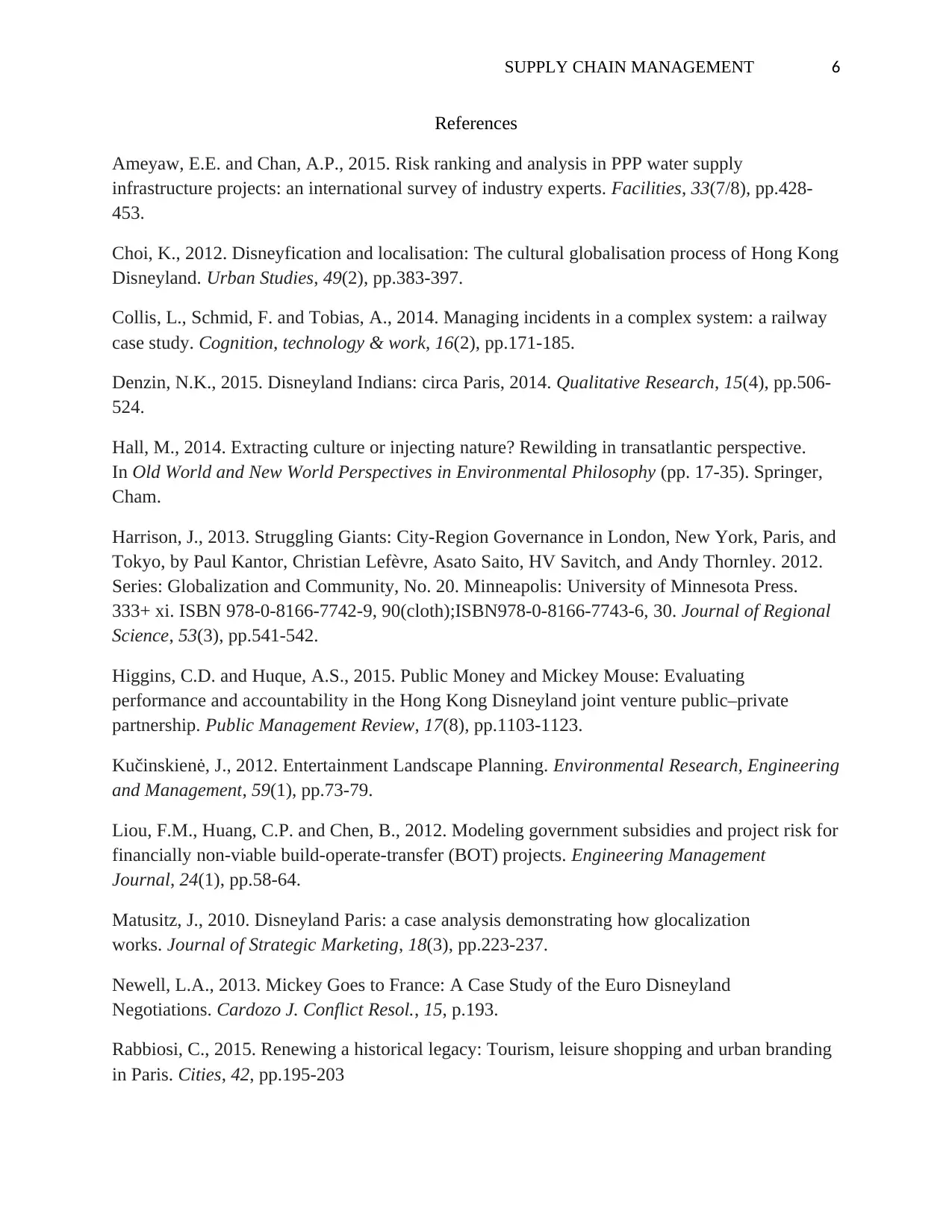
SUPPLY CHAIN MANAGEMENT 6
References
Ameyaw, E.E. and Chan, A.P., 2015. Risk ranking and analysis in PPP water supply
infrastructure projects: an international survey of industry experts. Facilities, 33(7/8), pp.428-
453.
Choi, K., 2012. Disneyfication and localisation: The cultural globalisation process of Hong Kong
Disneyland. Urban Studies, 49(2), pp.383-397.
Collis, L., Schmid, F. and Tobias, A., 2014. Managing incidents in a complex system: a railway
case study. Cognition, technology & work, 16(2), pp.171-185.
Denzin, N.K., 2015. Disneyland Indians: circa Paris, 2014. Qualitative Research, 15(4), pp.506-
524.
Hall, M., 2014. Extracting culture or injecting nature? Rewilding in transatlantic perspective.
In Old World and New World Perspectives in Environmental Philosophy (pp. 17-35). Springer,
Cham.
Harrison, J., 2013. Struggling Giants: City‐Region Governance in London, New York, Paris, and
Tokyo, by Paul Kantor, Christian Lefèvre, Asato Saito, HV Savitch, and Andy Thornley. 2012.
Series: Globalization and Community, No. 20. Minneapolis: University of Minnesota Press.
333+ xi. ISBN 978‐0‐8166‐7742‐9, 90(cloth);ISBN978‐0‐8166‐7743‐6, 30. Journal of Regional
Science, 53(3), pp.541-542.
Higgins, C.D. and Huque, A.S., 2015. Public Money and Mickey Mouse: Evaluating
performance and accountability in the Hong Kong Disneyland joint venture public–private
partnership. Public Management Review, 17(8), pp.1103-1123.
Kučinskienė, J., 2012. Entertainment Landscape Planning. Environmental Research, Engineering
and Management, 59(1), pp.73-79.
Liou, F.M., Huang, C.P. and Chen, B., 2012. Modeling government subsidies and project risk for
financially non-viable build-operate-transfer (BOT) projects. Engineering Management
Journal, 24(1), pp.58-64.
Matusitz, J., 2010. Disneyland Paris: a case analysis demonstrating how glocalization
works. Journal of Strategic Marketing, 18(3), pp.223-237.
Newell, L.A., 2013. Mickey Goes to France: A Case Study of the Euro Disneyland
Negotiations. Cardozo J. Conflict Resol., 15, p.193.
Rabbiosi, C., 2015. Renewing a historical legacy: Tourism, leisure shopping and urban branding
in Paris. Cities, 42, pp.195-203
References
Ameyaw, E.E. and Chan, A.P., 2015. Risk ranking and analysis in PPP water supply
infrastructure projects: an international survey of industry experts. Facilities, 33(7/8), pp.428-
453.
Choi, K., 2012. Disneyfication and localisation: The cultural globalisation process of Hong Kong
Disneyland. Urban Studies, 49(2), pp.383-397.
Collis, L., Schmid, F. and Tobias, A., 2014. Managing incidents in a complex system: a railway
case study. Cognition, technology & work, 16(2), pp.171-185.
Denzin, N.K., 2015. Disneyland Indians: circa Paris, 2014. Qualitative Research, 15(4), pp.506-
524.
Hall, M., 2014. Extracting culture or injecting nature? Rewilding in transatlantic perspective.
In Old World and New World Perspectives in Environmental Philosophy (pp. 17-35). Springer,
Cham.
Harrison, J., 2013. Struggling Giants: City‐Region Governance in London, New York, Paris, and
Tokyo, by Paul Kantor, Christian Lefèvre, Asato Saito, HV Savitch, and Andy Thornley. 2012.
Series: Globalization and Community, No. 20. Minneapolis: University of Minnesota Press.
333+ xi. ISBN 978‐0‐8166‐7742‐9, 90(cloth);ISBN978‐0‐8166‐7743‐6, 30. Journal of Regional
Science, 53(3), pp.541-542.
Higgins, C.D. and Huque, A.S., 2015. Public Money and Mickey Mouse: Evaluating
performance and accountability in the Hong Kong Disneyland joint venture public–private
partnership. Public Management Review, 17(8), pp.1103-1123.
Kučinskienė, J., 2012. Entertainment Landscape Planning. Environmental Research, Engineering
and Management, 59(1), pp.73-79.
Liou, F.M., Huang, C.P. and Chen, B., 2012. Modeling government subsidies and project risk for
financially non-viable build-operate-transfer (BOT) projects. Engineering Management
Journal, 24(1), pp.58-64.
Matusitz, J., 2010. Disneyland Paris: a case analysis demonstrating how glocalization
works. Journal of Strategic Marketing, 18(3), pp.223-237.
Newell, L.A., 2013. Mickey Goes to France: A Case Study of the Euro Disneyland
Negotiations. Cardozo J. Conflict Resol., 15, p.193.
Rabbiosi, C., 2015. Renewing a historical legacy: Tourism, leisure shopping and urban branding
in Paris. Cities, 42, pp.195-203
⊘ This is a preview!⊘
Do you want full access?
Subscribe today to unlock all pages.

Trusted by 1+ million students worldwide
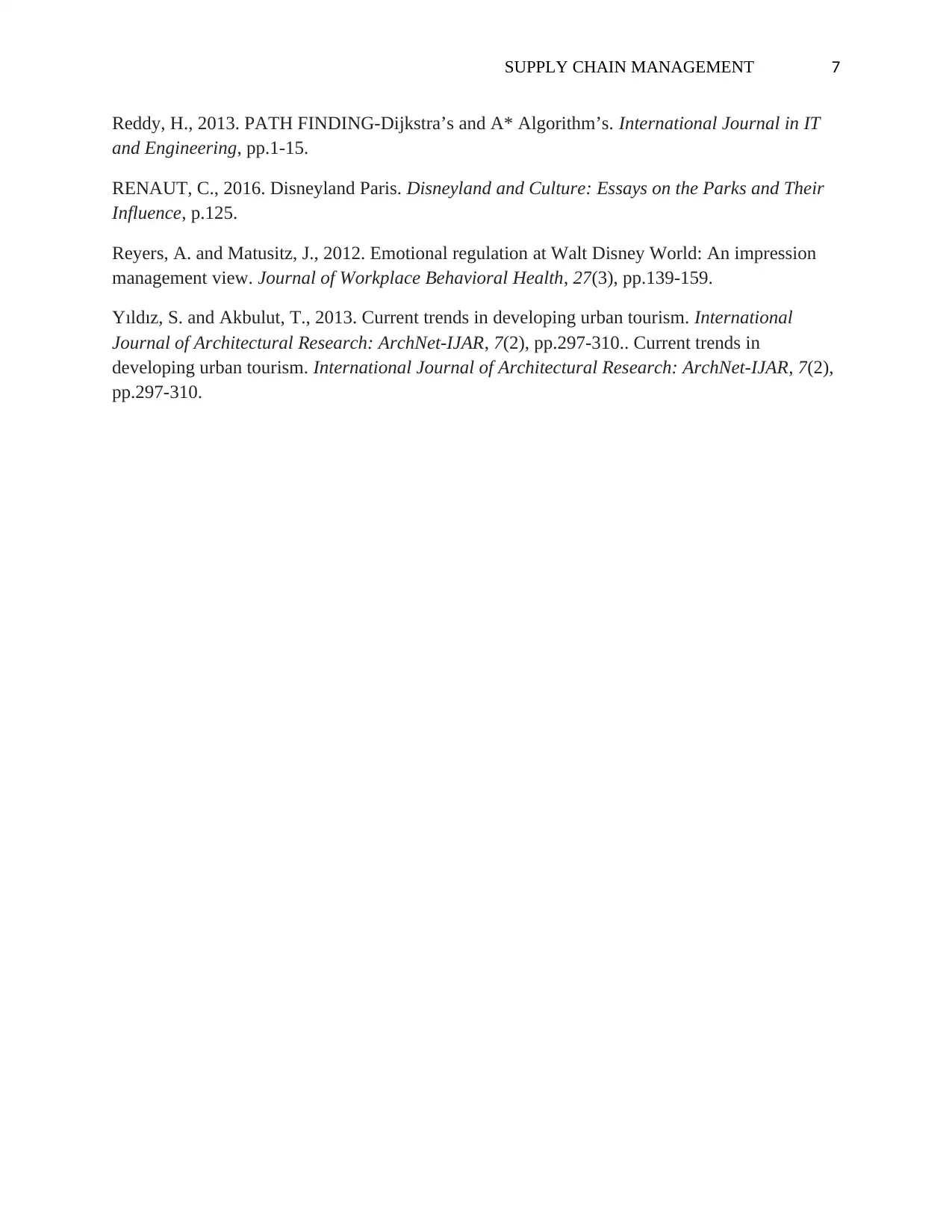
SUPPLY CHAIN MANAGEMENT 7
Reddy, H., 2013. PATH FINDING-Dijkstra’s and A* Algorithm’s. International Journal in IT
and Engineering, pp.1-15.
RENAUT, C., 2016. Disneyland Paris. Disneyland and Culture: Essays on the Parks and Their
Influence, p.125.
Reyers, A. and Matusitz, J., 2012. Emotional regulation at Walt Disney World: An impression
management view. Journal of Workplace Behavioral Health, 27(3), pp.139-159.
Yıldız, S. and Akbulut, T., 2013. Current trends in developing urban tourism. International
Journal of Architectural Research: ArchNet-IJAR, 7(2), pp.297-310.. Current trends in
developing urban tourism. International Journal of Architectural Research: ArchNet-IJAR, 7(2),
pp.297-310.
Reddy, H., 2013. PATH FINDING-Dijkstra’s and A* Algorithm’s. International Journal in IT
and Engineering, pp.1-15.
RENAUT, C., 2016. Disneyland Paris. Disneyland and Culture: Essays on the Parks and Their
Influence, p.125.
Reyers, A. and Matusitz, J., 2012. Emotional regulation at Walt Disney World: An impression
management view. Journal of Workplace Behavioral Health, 27(3), pp.139-159.
Yıldız, S. and Akbulut, T., 2013. Current trends in developing urban tourism. International
Journal of Architectural Research: ArchNet-IJAR, 7(2), pp.297-310.. Current trends in
developing urban tourism. International Journal of Architectural Research: ArchNet-IJAR, 7(2),
pp.297-310.
1 out of 7
Related Documents
Your All-in-One AI-Powered Toolkit for Academic Success.
+13062052269
info@desklib.com
Available 24*7 on WhatsApp / Email
![[object Object]](/_next/static/media/star-bottom.7253800d.svg)
Unlock your academic potential
Copyright © 2020–2025 A2Z Services. All Rights Reserved. Developed and managed by ZUCOL.



